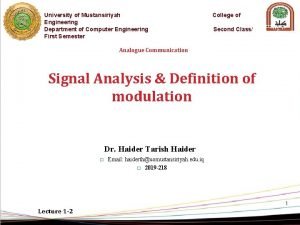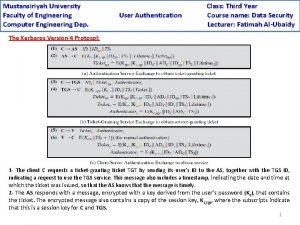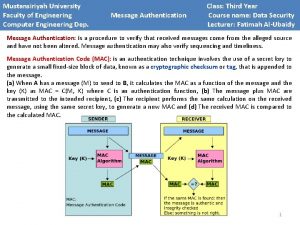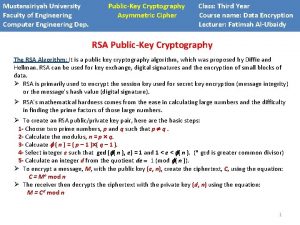University of Mustansiriyah Engineering Department of Computer Engineering














- Slides: 14

University of Mustansiriyah Engineering Department of Computer Engineering First Semester College of Second Class/ Analogue Communication Introduction to communication Dr. Haider Tarish Haider � Email: haiderth@uomustansiriyah. edu. iq � 2019 -218 1 Lecture 1 -1

Course plan: 1 -Introduction to communication systems, Signal analysis (System impulse response, band width, energy and power calculation. 2 -Definition of modulation, types of modulation and reasons for modulation. 3 -Amplitude Modulation (AM), definition, spectrum & power calculation. 4 -Generation and detection of AM signals, tutorial. 5 -Double side band DSB Generation and demodulation 6 -Single side band SSB Generation and demodulation 7 -Vestigial Side Band VSB Modulation generation and demodulation 8 -Super Heterodyne AM Receiver and Introduction to angle modulation. Lecture 1 -1 2

Course plane: 9 -Frequency Modulation (FM), Narrow and wideband FM, definition, bandwidth, spectrum and power. 10 -Wideband FM, definition, bandwidth, spectrum and power. 11 -Super Heterodyne FM Receiver, Stereo FM, Frequency Division Multiplexing (FDM). 12 -Noise: mathematical representation, classification, power and spectral density. Thermal noise and additive white Gaussian noise. 13 -Noise in Amplitude Modulation (Normal AM, DSB, SSB) communication systems, tutorial. 14 -Figure of Merit and Noise in analogue communication systems, tutorial. 15 -Noise Comparison of FM and AM, tutorial. Lecture 1 -1 3

References: 1 - Bruce Carlson etl “An Introduction to Signals and Noise in Electrical Communication”, Mc. Graw-Hill Companies, Inc. , 2002. 2 - John G Proakis and Masoud Salehi “Communication Systems Engineering”, Prentice-Hall, Inc. , 2002. 3 - Simon Haykin “Communication systems”, John Wiley and sons, Inc. , 2001 4 - Lloyd T. and Mitchel E. S. , “Theory and problems of Electronic Communication”, Schaum’s outline Series, Mc. GRAW-Hill, 1998. 5 - B. P. Lathi, “Modern Digital and Analog Communication system”, Oxford University press, Inc. , 1998. Lecture 1 -1 4

Introduction to Communication System What is communication? It's the process in which information is transfer from one point in space and time called the source to another point destination. What is a communication system? It's the group of mechanism that provides the information link between source and destination. What is the purpose of a communication system? The purpose of a communication system is to transmit information signals through a communication channel. Source: https: //jooinn. com/communicationsystem. html Fundamentals of Communication system: Frequencies Frequency is measured in hertz (Hz), equivalent to cycles per second: thus 1 Hz is 1 c/s. The electromagnetic spectrum consists of frequencies from just above 0 Hz to ∞ Hz. The frequency spectrum is broken up into different segments which indicate the usage for particular frequency range as shown in table below. Lecture 1 -1 5

Introduction to Communication System Common Frequency ranges The frequency band of 20 Hz to 21 k. Hz is the total band that the human ear can hear. Types of Signal There are only two different types of signal that are processed, transmitted and received by telecommunication equipment. These are analogue and digital. Each type has individual characteristics. Lecture 1 -1 6

Introduction to Communication System Analogue Signal An analogue signal is defined as a continuous waveform having a positive peak and a negative peak and having an infinite range of levels. An analogue signal has no discontinuous points, i. e. it follows an unbroken curve for its full duration. Typical analogue waveforms are e. g. voice, temperature, etc. as shown in Fig. below. Digital Signal Representation variable takes on a finite & countable number of values in a given interval, e. g. text, digitized images, etc. as shown in Fig. below. Lecture 1 -1 7

Introduction to Communication System Signalf of the analogue wave is determined by the The. Analogue frequency following formula: An analogue signal is defined as a continuous waveform having a positive peak and a negative peak and having an infinite range of levels. An analogue signal has no discontinuous points, i. e. it follows an unbroken curve for its full duration. Typical analogue waveforms are e. g. voice, temperature, etc. as shown in Fig. below. Digital where c =Signal velocity of light in a vacuum = 3 × 108 m/s The wave forms shown are shown in the time domain, Representation variable takes in on figure a finite above & countable number that of values a given interval, which means the inamplitude is plotted against time. A sine wave and e. g. text, digitized images, etc. as shown in Fig. a cosine wave consist of a single frequency. A complex wave is a wave below. that consists of a number of different frequencies. Lecture 1 -1 8

Introduction to Communication System Measurement of Signal Level The gain or loss of a network can be expressed as a ratio of output power over input power. If the output power is greater than the input power then the network has a power ratio > 1, which means that the network has a gain. If the output power is less than the input power then the network has a power ratio < 1, which means that the network has a loss. If the power ratio equals 1 then the network has a unity gain. Instead of measuring the power a signal dissipates in watts, it is easier to measure the signal level. The unit of measurement is the bel, but this is a rather large unit for practical purposes, so instead the decibel is used. The Decibel A decibel (d. B) is one-tenth of a bel and can be defined as the loss or gain of a network in a logarithmic form. N Power in (Pi ) Power out (Pout) The loss or gain N ratio of the network shown above is given as follows: Lecture 1 -1 9

Introduction to Communication System The above equation yields a ratio as both the output power and the input power are in watts. To enable a unit of measurement to be attached to this ratio, the following formula is used: , A decibel is 1/10 of a bel (B) The advantage of using the decibel as a unit of measurement is that the individual gains of the individual networks can be added together instead of being multiplied together. Example: Determine a formula for the overall gain of the three cascaded networks shown below as a ratio and in d. B. Pout Pin P 1 N Lecture 1 -1 P 2 N N 10

Introduction to Communication System Example: Calculate the gain or loss of each of the following networks in d. B: 1. Input power is 4 µW and output power is 16 µW. 2. I n p u t power is 4 m. W and output power is 16 m. W. 3. I n p u t power is 4 W and output power is 16 W. Lecture 1 -1 11

Introduction to Communication System The d. Bm: This unit of measurement is used to measure the actual power at a point in a system relative to 1 m. W. This indicates whether the power at the point is greater than 1 m. W or less than 1 m. W. The d. Bm is defined as the gain or loss of a network, where the reference signal power is 1 m. W, and the power ratio is expressed in a logarithmic form. This is shown by Lecture 1 -1 12

Introduction to Communication System As can be seen in the above example the level in d. Bm indicates the actual power in the signal relative to 1 m. W. Table below illustrates this relationship Relationship between power and d. Bm Lecture 1 -1 13

Q&A Thank You 14
 Computer science department columbia
Computer science department columbia Department of information engineering university of padova
Department of information engineering university of padova Information engineering padova
Information engineering padova University of sargodha engineering department
University of sargodha engineering department Tum
Tum Computer engineering department
Computer engineering department Bridgeport engineering department
Bridgeport engineering department Northwestern computer science department
Northwestern computer science department Hacettepe university computer engineering
Hacettepe university computer engineering What is system in software engineering
What is system in software engineering Department of law university of jammu
Department of law university of jammu Department of geology university of dhaka
Department of geology university of dhaka University of padova psychology
University of padova psychology University of bridgeport it department
University of bridgeport it department University of iowa math department
University of iowa math department



























